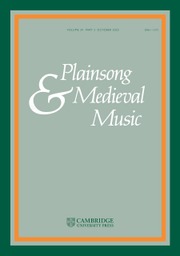No CrossRef data available.
Article contents
New observations on the quilisma: occurrence, position and function in northern Low Countries sources
Published online by Cambridge University Press: 22 November 2024
Abstract
The quilisma is a sign found in the earliest surviving notations of Gregorian chant. Since the ‘chant restoration’ of the nineteenth and twentieth centuries, the sign is included once again in all chant books, and poses an inevitable question of interpretation to those studying and performing chant. However, since medieval times, there has been considerable debate whether the sign denotes a particular method of voice production, a particular rhythmic value and/or an element in a melody's modal orientation. Chant manuscripts of the northern Low Countries (the northern half of the modern-day Netherlands), although not well known for their melodic content, point to highly interesting developments in response to a continually changing musical aesthetic. Likewise, these manuscripts offer new insights into the quality of the quilisma: the sign was widely used in the region up to the sixteenth-century Dutch Revolt, and for much longer than in the better-known square notation. Through analytical and comparative study, the sign's occurrence, position, development, relation to other signs and functions are clarified and presented in this article along with insights into its unique notational development.
- Type
- Research Article
- Information
- Copyright
- Copyright © The Author(s), 2024. Published by Cambridge University Press
References
1 Floros, Constantin, The Origins of Western Notation, rev. and trans. Moran, Neil (Frankfurt am Main, 2011), 71–85Google Scholar.
2 Tack, Franz, Der gregorianische Choral, (Das Musikwerk Vol. XVIII) (Cologne, 1960), 9ffGoogle Scholar.
3 Wiesli, Walter, Das Quilisma im Codex 359 der Stiftsbibliothek St. Gallen (Immensee, 1966), 1–19Google Scholar.
4 Gerritsen-Geywitz, Gisela, ‘Veertiende-eeuws Utrechts penwerk’, in Manuscripten en miniaturen. Studies aangeboden aan Anne. S. Korteweg bij haar afscheid van de Koninklijke Bibliotheek, ed. Biemans, Jos, van der Hoek, Klaas, Rudy, Kathryn M. and van der Vlist, Ed (Zutphen, 2007), 101–12Google Scholar.
5 For a comparison of the quilisma in St Gall, Stiftsbibliothek, 390 (‘Hartker’, which includes the ‘three-curled’ quilisma) and Utrecht, Universiteitsbibliotheek, 406, see Ike de Loos, ‘German and Dutch Musical Notations in the Twelfth and Thirteenth Centuries’, Ph.D. diss., University of Utrecht (1996), ch. 5. The conclusion is that Hartker's three-curled quilisma is not the same neume as that found in Utrecht, Universiteitsbibliotheek, 406, which is a quilisma-pes directly preceded by a unison punctum.
6 For most sources, their origin and the location(s) of their use are undisputedly attested. A small number of sources have been moved from one church to the other, but this often concerned nearby towns or cities, still within the diocese; an example of this is ms. 6.
7 These chants were entered into worksheets of the program Excel to enable searches and calculations. The transcription sheets can be found in the appendix of Rens Tienstra, ‘Melodic Variation in Northern Low Countries Chant Manuscripts (1150–1600)’, Ph.D. diss., Folkwang Universität der Künste, Essen (2020); the methodology is explained in chapter 3. Owing to size, they are not included in this article. They can be viewed freely online via the author's website: www.renstienstra.nl. In summary, each pitch is represented by a letter, ranging from Γ, a, b, c, etc. to q (following the alphabetic pitch system of the Antiphonary-Tonary-Missal of St Benigne, Dijon, Montpellier, Bibliothèque Inter-Universitaire, Section Médecine, H196), with the addition of special signs to indicate quilisma (*), oriscus (+), liquescence (#), apostropha (~) and trigon (!) among others. Different search functions are added to the totality of sheets.
8 In the oldest diastematic neume notations containing so-called ‘East-Frankish’ melodic traditions similar to the Utrecht sources (e.g., Klosterneuburg and Karlsruhe Badische Landesbibliothek Aug.LX), the quilisma-pes is almost exclusively positioned on minor thirds. Unlike the quilisma-pes, the pes quassus occurs more regularly in positions outside the minor third. In fact, it is regularly found at whole tone positions.
9 Praßl, Franz Karl, ‘Beobachtungen zur adiastematischen Notation in Missalienhandschriften des 12. Jahrhunderts aus dem Augustiner-Chorherrenstift Seckau’, Cantus Planus. International Musicological Society Study Group: Papers Read at the Fourth Meeting, Pécs, Hungary, 3–8 September 1990 (Budapest, 1992), 31–54Google Scholar.
10 de Loos, ‘German and Dutch Musical Notations’, 139.
11 Cardine, Eugène, Gregorian Semiology, trans. Fowells, Robert M. (Solesmes, 1982), 184–214Google Scholar.
12 The manuscript can be viewed online: https://dspace.library.uu.nl/handle/1874/333902.
13 Cardine, Gregorian Semiology, 50.
14 In literature, I could only find it listed in ‘The Neumatic Alphabet of NL-Uu406’ in de Loos, ‘German and Dutch Musical Notations’, 91. De Loos only described it as a ‘tractulus-like neume’, nothing more.
15 Utrecht, Catharijneconvent, ABM h62; Universiteitsbibliotheek mss. 406 and 417. The sign was also found in the twelfth-century antiphoner fragments of Utrecht's St Paul's abbey (the oldest known diastematic notations from the northern Low Countries): E fol. 149 (pdf digitalisation: page 14, line 11, ending), responsory Beata viscera, on the word ‘hodie’; in the same chant, it is perhaps also included in ‘lactaverunt’. Furthermore, E fol. 68, resp. Sancte Dei preciose (pdf: page 19), melisma of ‘collegio’.
16 David Hiley, Western Plainchant: A Handbook (Oxford, 1993), 385.
17 Unique melisma.
18 In oldest layer of notation.
19 Different pitches than the other sources for a quilisma in the same position: [fg].



